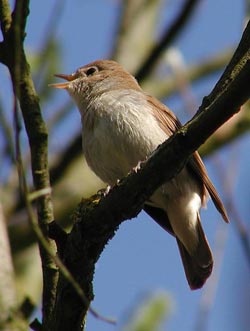Communicating Nightingales: Older Males Trill Better

The Older, the Better: Singing male nightingale.<br>Photo: Kathryn Peiman / Petite Camargue Alsacienne <br>
These findings were published by researchers at the University of Basel and the Netherlands Institute of Ecology in the online edition of «Journal of Avian Biology». With up to 100 trill elements a second, nightingales belong to the fastest singers.
Nightingales are famous for their large song repertoire: Each male can perform around 200 different song types. Facing this great variety, how can a female listener assess correctly if the male counterpart is a suitable mating partner? It is unlikely that the size of the repertoire is used as a performance indicator, since it would take about one hour for a male nightingale to sing through its whole song list. Thus, it is more likely that the quality of certain elements or song types are attended to for quick assessment.
Around 20 percent of nightingale songs contain rapid broadband trills that are characterized by particularly large frequency bandwidths. Since the performance of these sounds is very demanding, the rate at which they can be repeated is limited: «Trying to sing rapidly increasing sounds in fast repetition is very hard for us humans as well» says PD Dr. Valentin Amrhein, Zoologist at the University of Basel and head of the research station Petite Camargue Alsacienne in which the data was collected. Singing rapid broadband trills comes at a certain price for the male nightingale. Thus, it is suggested that males in good physical condition trill better and that therefore, trilling is a good indicator for male «quality».
Indeed, the scientists found out that older male nightingales perform faster trills with a broader frequency range than younger males. Based on the trills, females could therefore assess the age of the male singer and mate preferably with older ones. This behavior makes sense for female birds because older males are often more successful in reproduction.
Compared to 46 bird species investigated in other studies, the nightingale holds an exceptional position: The males use trills with a frequency bandwidth and repetition rates twice as wide or fast than that measured in other birds. This makes the nightingale one of the most sophisticated singers.
Original Source
Philipp Sprau, Tobias Roth, Valentin Amrhein & Marc Naguib
The predictive value of trill performance in a large repertoire songbird, the nightingale Luscinia megarhynchos
Journal of Avian Biology, 2013 | doi: 10.1111/j.1600-048X.2013.00113.x
Further Information
• PD Dr. Valentin Amrhein, University of Basel, Zoological Institute, tel. +41 79 848 99 33, email: v.amrhein@unibas.ch
• Dr. Philipp Sprau, Max-Planck-Institut für Ornithologie, Forschungsgruppe Evolutionäre Ökologie von Variation, tel. +49 179 597 99 83, email: psprau@orn.mpg.de
Weitere Informationen:
http://dx.doi.org/10.1111/j.1600-048X.2013.00113.x – Abstract
Media Contact
More Information:
http://www.unibas.chAll latest news from the category: Life Sciences and Chemistry
Articles and reports from the Life Sciences and chemistry area deal with applied and basic research into modern biology, chemistry and human medicine.
Valuable information can be found on a range of life sciences fields including bacteriology, biochemistry, bionics, bioinformatics, biophysics, biotechnology, genetics, geobotany, human biology, marine biology, microbiology, molecular biology, cellular biology, zoology, bioinorganic chemistry, microchemistry and environmental chemistry.
Newest articles

Innovative 3D printed scaffolds offer new hope for bone healing
Researchers at the Institute for Bioengineering of Catalonia have developed novel 3D printed PLA-CaP scaffolds that promote blood vessel formation, ensuring better healing and regeneration of bone tissue. Bone is…

The surprising role of gut infection in Alzheimer’s disease
ASU- and Banner Alzheimer’s Institute-led study implicates link between a common virus and the disease, which travels from the gut to the brain and may be a target for antiviral…

Molecular gardening: New enzymes discovered for protein modification pruning
How deubiquitinases USP53 and USP54 cleave long polyubiquitin chains and how the former is linked to liver disease in children. Deubiquitinases (DUBs) are enzymes used by cells to trim protein…



